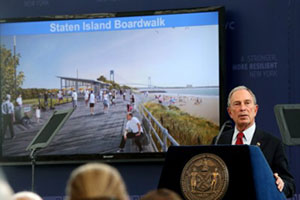Yesterday, NYC Mayor Bloomberg presented a creative, thoughtful plan to protect the city from the inevitable impacts of climate change, setting a precedent for other cities to follow.
The $20 billion plan, "A Stronger, More Resilient New York," includes a wide range of projects, from restoring dunes and wetlands to vegetating streets and rooftops to absorb water, and building levees, flood walls and other defenses. Bulkheads of stone would hold shorelines in place and protect against
rising sea levels throughout the 520 miles of the city’s waterfront.
It modifies the building code and allocates funds to flood-proof homes and other buildings like hospitals, upgrades to power and telecommunications infrastructure and sets standards for phone and Internet providers to get systems back online after major storms.
"Instead of colliding with ocean-facing homes, waves rushing toward our city will hit breakwaters and wetlands that will help sap their strength and break their momentum," says Bloomberg.
Some of his recommendations would literally reshape parts of the city, such as Lower Manhattan’s waterfront and a potential new "Seaport City" on the East Side.
The plan avoids the really expensive, difficult stuff, like moving people out of coastal communities and building major projects like sea barriers with gates and levees.
Rather, it focuses on lower tech responses, many of which focus on returning nature to its role of protecting the land and combining uses of protective structures so they are also function as elevated parks and boardwalks, for example.
Staten Island, among the hardest hit areas, would get protection that doubles as a new boardwalk:

"This is urgent work, and it must begin now," says Bloomberg. "As bad as Sandy was, future storms could be even worse. In fact, because of rising temperatures and sea levels, even a storm that’s not as large as Sandy could – down the road – be even more destructive… We have to look ahead and anticipate any and all future threats, not only from hurricanes but also from droughts, heavy downpours and heat waves – which may be longer, and more intense, in the years to come."
The plan is based on the recommendations of the New York City Panel on Climate Change, the task force that created PlaNYC in 2008 (the city’s ambitious sustainability plan) and which he reconvened after Hurricane Sandy. During the past six months, they conducted a crash process that included input from state and federal agencies, community organizations and citizens.
Their data shows what NYC faces:
- Sea levels could rise at a faster rate than forecast just four years ago – potentially by more than 2.5 feet by the 2050s.
By mid-century. 25% the city’s land area will be in the floodplain, according to FEMA’s new flood maps. That puts 800,000 residents at risk – more than 40 miles of waterfront would flood on a regular basis, just during normal high tide.
- By the 2050s, the city could have three times as many days at or above 90 degrees – the Alabama-style heat would threaten public health and the power system, among other infrastructure systems.
- The number of days with more than two inches of rainfall will rise dramatically – NYC had record rains this week of over 4" in one day.
- Costs of storms will increase: Sandy totaled $19 billion in damage and economic loss; in 2025, that cost grows to $35 billion and by 2055, $90 billion.
City and federal funds for Sandy relief cover $15 billion, and the rest could be raised through municipal bonds or even a small surcharge on homeowners’ insurance – about $1 a month on a $1,000 premium.
While some may scoff at the $20 billion price of implementing the plan, it’s exactly the cost for cleanup after Sandy.
The panel’s report creates comprehensive plans for strengthening 15 critical areas including coastal defense, buildings, utilities, fuel and food supply, healthcare, transportation, and telecommunications.
It examines all 15 areas from top-to-bottom examining their infrastructure, governance, how they were impacted by Sandy, the most significant risks they face from climate change, and what exactly can be done to better prepare them for future weather events.
The report also zooms in on areas that suffered the most damage from Sandy. The panel examined and addressed each community’s specific vulnerabilities with a tailored plan to make them more resilient.

Bloomberg has less than seven months in office, but he plans to get a head start before he leaves, with the hope that the next mayor will continue the work.
